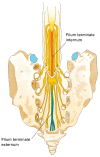The Surgical Histopathology of the Filum Terminale: Findings from a Large Series of Patients with Tethered Cord Syndrome
- PMID: 38202013
- PMCID: PMC10779556
- DOI: 10.3390/jcm13010006
The Surgical Histopathology of the Filum Terminale: Findings from a Large Series of Patients with Tethered Cord Syndrome
Abstract
This study investigated the prevalence of embryonic and connective tissue elements in the filum terminale (FT) of patients with tethered cord syndrome (TCS), examining both typical and pathological histology. The FT specimens from 288 patients who underwent spinal cord detethering from 2013 to 2021 were analyzed. The histopathological examination involved routine hematoxylin and eosin staining and specific immunohistochemistry when needed. The patient details were extracted from electronic medical records. The study found that 97.6% of the FT specimens had peripheral nerves, and 70.8% had regular ependymal cell linings. Other findings included ependymal cysts and canals, ganglion cells, neuropil, and prominent vascular features. Notably, 41% showed fatty infiltration, and 7.6% had dystrophic calcification. Inflammatory infiltrates, an underreported finding, were observed in 3.8% of the specimens. The research highlights peripheral nerves and ganglion cells as natural components of the FT, with ependymal cell overgrowth and other tissues potentially linked to TCS. Enlarged vessels may suggest venous congestion due to altered FT mechanics. The presence of lymphocytic infiltrations and calcifications provides new insights into structural changes and mechanical stress in the FT, contributing to our understanding of TCS pathology.
Keywords: filum terminale; spinal cord disorders; tethered cord release; tethered cord syndrome.
Conflict of interest statement
The authors declare no conflict of interest.
Figures





Similar articles
-
[Diagnosis and surgical treatment of tethered cord syndrome accompanied by congenital dermal sinus tract in adults].Beijing Da Xue Xue Bao Yi Xue Ban. 2022 Dec 18;54(6):1163-1166. doi: 10.19723/j.issn.1671-167X.2022.06.017. Beijing Da Xue Xue Bao Yi Xue Ban. 2022. PMID: 36533349 Free PMC article. Chinese.
-
Diseased Filum Terminale as a Cause of Tethered Cord Syndrome in Ehlers-Danlos Syndrome: Histopathology, Biomechanics, Clinical Presentation, and Outcome of Filum Excision.World Neurosurg. 2022 Jun;162:e492-e502. doi: 10.1016/j.wneu.2022.03.038. Epub 2022 Mar 17. World Neurosurg. 2022. PMID: 35307588
-
A comparative study of histopathological analysis of filum terminale in patients with tethered cord syndrome and in normal human fetuses.Pediatr Neurosurg. 2011;47(6):412-6. doi: 10.1159/000338981. Epub 2012 Jul 7. Pediatr Neurosurg. 2011. PMID: 22776912
-
Minimal tethered cord syndrome: what's necessary to justify a new surgical indication?Neurosurg Focus. 2007;23(2):E1. doi: 10.3171/FOC-07/08/E1. Neurosurg Focus. 2007. PMID: 17961010 Review.
-
Pathophysiology of tethered cord syndrome and other complex factors.Neurol Res. 2004 Oct;26(7):722-6. doi: 10.1179/016164104225018027. Neurol Res. 2004. PMID: 15494111 Review.
Cited by
-
Morphological analysis of the filum terminale and detailed description of the distal filum terminale externum: a cadaveric study.Front Neuroanat. 2025 Mar 25;19:1547165. doi: 10.3389/fnana.2025.1547165. eCollection 2025. Front Neuroanat. 2025. PMID: 40201577 Free PMC article.
-
Neuraxial biomechanics, fluid dynamics, and myodural regulation: rethinking management of hypermobility and CNS disorders.Front Neurol. 2024 Dec 10;15:1479545. doi: 10.3389/fneur.2024.1479545. eCollection 2024. Front Neurol. 2024. PMID: 39719977 Free PMC article. Review.
-
Comorbidities and neurosurgical interventions in a cohort with connective tissue disorders.Front Neurol. 2025 Jan 22;15:1484504. doi: 10.3389/fneur.2024.1484504. eCollection 2024. Front Neurol. 2025. PMID: 39931100 Free PMC article.
-
Occult tethered cord syndrome: insights into clinical and MRI features, prognostic factors, and treatment outcomes in 30 dogs with confirmed or presumptive diagnosis.Front Vet Sci. 2025 Jul 11;12:1588538. doi: 10.3389/fvets.2025.1588538. eCollection 2025. Front Vet Sci. 2025. PMID: 40717908 Free PMC article.
-
Anatomical and histological characterization of the filum terminale in dogs.Front Vet Sci. 2025 Jul 24;12:1650893. doi: 10.3389/fvets.2025.1650893. eCollection 2025. Front Vet Sci. 2025. PMID: 40777825 Free PMC article.
References
-
- Klinge P.M., Srivastava V., McElroy A., Leary O.P., Ahmed Z., Donahue J.E., Brinker T., De Vloo P., Gokaslan Z.L. Diseased Filum Terminale as a Cause of Tethered Cord Syndrome in Ehlers-Danlos Syndrome: Histopathology, Biomechanics, Clinical Presentation, and Outcome of Filum Excision. World Neurosurg. 2022;162:e492–e502. doi: 10.1016/j.wneu.2022.03.038. - DOI - PubMed
LinkOut - more resources
Full Text Sources

